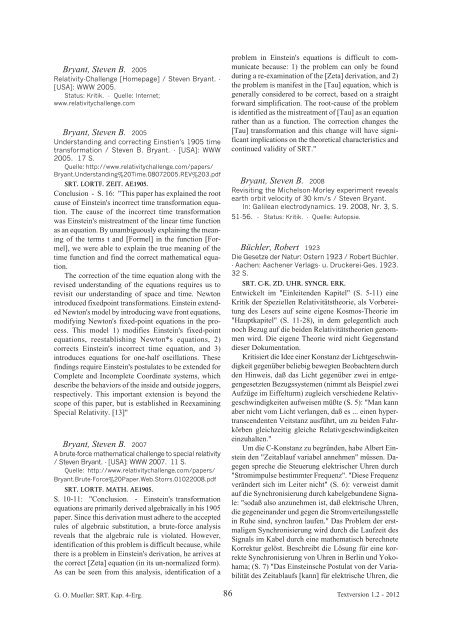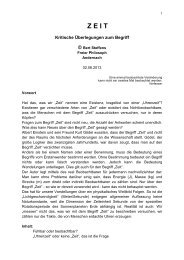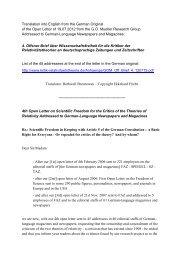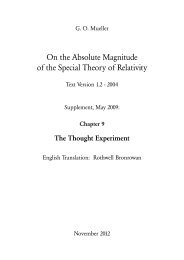2394 weitere kritische Veröffentlichungen - Kritische Stimmen zur ...
2394 weitere kritische Veröffentlichungen - Kritische Stimmen zur ...
2394 weitere kritische Veröffentlichungen - Kritische Stimmen zur ...
Erfolgreiche ePaper selbst erstellen
Machen Sie aus Ihren PDF Publikationen ein blätterbares Flipbook mit unserer einzigartigen Google optimierten e-Paper Software.
Bryant, Steven B. 2005<br />
Relativity-Challenge [Homepage] / Steven Bryant. -<br />
[USA]: WWW 2005.<br />
Status: Kritik. - Quelle: Internet;<br />
www.relativitychallenge.com<br />
Bryant, Steven B. 2005<br />
Understanding and correcting Einstien's 1905 time<br />
transformation / Steven B. Bryant. - [USA]: WWW<br />
2005. 17 S.<br />
Quelle: http://www.relativitychallenge.com/papers/<br />
Bryant.Understanding%20Time.08072005.REV%203.pdf<br />
SRT. LORTF. ZEIT. AE1905.<br />
Conclusion - S. 16: "This paper has explained the root<br />
cause of Einstein's incorrect time transformation equation.<br />
The cause of the incorrect time transformation<br />
was Einstein's mistreatment of the linear time function<br />
as an equation. By unambiguously explaining the meaning<br />
of the terms t and [Formel] in the function [Formel],<br />
we were able to explain the true meaning of the<br />
time function and find the correct mathematical equation.<br />
The correction of the time equation along with the<br />
revised understanding of the equations requires us to<br />
revisit our understanding of space and time. Newton<br />
introduced fixedpoint transformations. Einstein extended<br />
Newton's model by introducing wave front equations,<br />
modifying Newton's fixed-point equations in the process.<br />
This model 1) modifies Einstein's fixed-point<br />
equations, reestablishing Newton*s equations, 2)<br />
corrects Einstein's incorrect time equation, and 3)<br />
introduces equations for one-half oscillations. These<br />
findings require Einstein's postulates to be extended for<br />
Complete and Incomplete Coordinate systems, which<br />
describe the behaviors of the inside and outside joggers,<br />
respectively. This important extension is beyond the<br />
scope of this paper, but is established in Reexamining<br />
Special Relativity. [13]"<br />
Bryant, Steven B. 2007<br />
A brute-force mathematical challenge to special relativity<br />
/ Steven Bryant. - [USA]: WWW 2007. 11 S.<br />
Quelle: http://www.relativitychallenge.com/papers/<br />
Bryant.Brute-Force%20Paper.Web.Storrs.01022008.pdf<br />
SRT. LORTF. MATH. AE1905.<br />
S. 10-11: "Conclusion. - Einstein's transformation<br />
equations are primarily derived algebraically in his 1905<br />
paper. Since this derivation must adhere to the accepted<br />
rules of algebraic substitution, a brute-force analysis<br />
reveals that the algebraic rule is violated. However,<br />
identification of this problem is difficult because, while<br />
there is a problem in Einstein's derivation, he arrives at<br />
the correct [Zeta] equation (in its un-normalized form).<br />
As can be seen from this analysis, identification of a<br />
G. O. Mueller: SRT. Kap. 4-Erg.<br />
86<br />
problem in Einstein's equations is difficult to communicate<br />
because: 1) the problem can only be found<br />
during a re-examination of the [Zeta] derivation, and 2)<br />
the problem is manifest in the [Tau] equation, which is<br />
generally considered to be correct, based on a straight<br />
forward simplification. The root-cause of the problem<br />
is identified as the mistreatment of [Tau] as an equation<br />
rather than as a function. The correction changes the<br />
[Tau] transformation and this change will have significant<br />
implications on the theoretical characteristics and<br />
continued validity of SRT."<br />
Bryant, Steven B. 2008<br />
Revisiting the Michelson-Morley experiment reveals<br />
earth orbit velocity of 30 km/s / Steven Bryant.<br />
In: Galilean electrodynamics. 19. 2008, Nr. 3, S.<br />
51-56. - Status: Kritik. - Quelle: Autopsie.<br />
Büchler, Robert 1923<br />
Die Gesetze der Natur: Ostern 1923 / Robert Büchler.<br />
- Aachen: Aachener Verlags- u. Druckerei-Ges. 1923.<br />
32 S.<br />
SRT. C-K. ZD. UHR. SYNCR. ERK.<br />
Entwickelt im "Einleitenden Kapitel" (S. 5-11) eine<br />
Kritik der Speziellen Relativitätstheorie, als Vorbereitung<br />
des Lesers auf seine eigene Kosmos-Theorie im<br />
"Hauptkapitel" (S. 11-28), in dem gelegentlich auch<br />
noch Bezug auf die beiden Relativitätstheorien genommen<br />
wird. Die eigene Theorie wird nicht Gegenstand<br />
dieser Dokumentation.<br />
Kritisiert die Idee einer Konstanz der Lichtgeschwindigkeit<br />
gegenüber beliebig bewegten Beobachtern durch<br />
den Hinweis, daß das Licht gegenüber zwei in entgegengesetzten<br />
Bezugssystemen (nimmt als Beispiel zwei<br />
Aufzüge im Eiffelturm) zugleich verschiedene Relativgeschwindigkeiten<br />
aufweisen müßte (S. 5): "Man kann<br />
aber nicht vom Licht verlangen, daß es ... einen hypertranscendenten<br />
Veitstanz ausführt, um zu beiden Fahrkörben<br />
gleichzeitig gleiche Relativgeschwindigkeiten<br />
einzuhalten."<br />
Um die C-Konstanz zu begründen, habe Albert Einstein<br />
den "Zeitablauf variabel annehmen" müssen. Dagegen<br />
spreche die Steuerung elektrischer Uhren durch<br />
"Stromimpulse bestimmter Frequenz". "Diese Frequenz<br />
verändert sich im Leiter nicht" (S. 6): verweist damit<br />
auf die Synchronisierung durch kabelgebundene Signale:<br />
"sodaß also anzunehmen ist, daß elektrische Uhren,<br />
die gegeneinander und gegen die Stromverteilungsstelle<br />
in Ruhe sind, synchron laufen." Das Problem der erstmaligen<br />
Synchronisierung wird durch die Laufzeit des<br />
Signals im Kabel durch eine mathematisch berechnete<br />
Korrektur gelöst. Beschreibt die Lösung für eine korrekte<br />
Synchronisierung von Uhren in Berlin und Yokohama;<br />
(S. 7) "Das Einsteinsche Postulat von der Variabilität<br />
des Zeitablaufs [kann] für elektrische Uhren, die<br />
Textversion 1.2 - 2012





